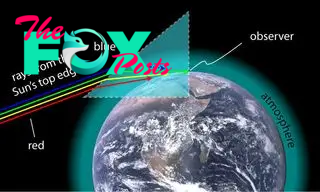Science
Why is there sometimes a green flash at sunset and sunrise?
As the sun dips below the horizon and the light starts to dim, lucky observers may spot a rare, brief flash of emerald. This is the "green flash," which can sometimes be seen right after sunset or before sunrise.
So what causes the green flash?
Like many colorful spectacles in the sky, such as rainbows, the green flash is the result of sunlight being separated into different colors. Normally, sunlight is white because it is made up of all of the wavelengths of visible light, Johannes Courtial, an optics researcher at the University of Glasgow, told Live Science. But when white light passes through a medium that is higher-density, like glass or water, at an angle, wavelengths of different colors start to bend and separate. This separation is called refraction.
Earth's atmosphere, with its varying density of gases, can refract light, too. It's why we sometimes see rainbow halos around the sun, or mirages in the distance, said Jan Null, a meteorologist based in California. Refraction is especially apparent when the sun gets closer to the horizon, because sunlight is entering the thickest part of the atmosphere at a particularly sharp angle. This is when the green flash may be visible, Null said.

Most green flashes fall into two categories. One type occurs just before the sun disappears. This is the one referenced in Jules Verne's novel "The Green Ray," Null said. But the type Null sees more often is when the sun is still above the water. "You get this light off the top of the disk," he said.
Related: When will the sun explode?
How to see the green flash
For the best chances of seeing this verdant flash, the right conditions need to align. First, you have to be able to see the sun while it's close to the horizon, like on the coast or high up in the mountains, Courtial said. In coastal areas like San Francisco, you're also most likely to spot the green flash on warmer days, when there's a layer of warm air on top of colder water, Null said. These layers of air help to refract sunlight.
-

 Science1h ago
Science1h agoHow to See the ‘Beaver’ Supermoon—the last of 2024
-

 Science5d ago
Science5d agoInside Capitol Hill’s Latest UFO Hearings
-

 Science5d ago
Science5d agoYou Won’t Want to Miss the Leonid Meteor Shower. Here’s How and When You Can See It
-

 Science5d ago
Science5d agoHere’s What Trump’s Win Means for NASA
-

 Science1w ago
Science1w agoWhy Risky Wildfire Zones Have Been Increasing Around the World
-

 Science1w ago
Science1w agoIt’s Time to Redefine What a Megafire Is in the Climate Change Era
-

 Science1w ago
Science1w ago4 Astronauts Return to Earth After Being Delayed by Boeing’s Capsule Trouble and Hurricane Milton
-

 Science1w ago
Science1w agoThe Elegance and Awkwardness of NASA’s New Moon Suit, Designed by Axiom and Prada



























